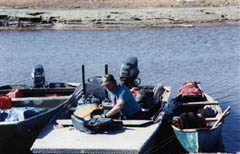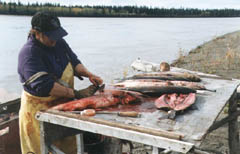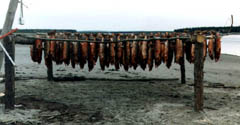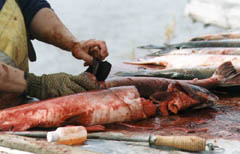Let's hop on the boats and go for a 10 mile ride to our fish camp. Our 18 foot, flat bottom river boat, pictured here next to one of our canoes, holds up to 6 people and gets us all over the Tanana and Yukon Rivers. "Bush" transportation is quite unique using rivers rather that roads. We feel at home in the boat, and spend more time on the water than in our truck.
We catch 1500-2000 fish per year to feed our team of 17 dogs throughout the winter and into the next summer. Silver and chum salmon are caught in the fall time. We cut the fish lengthwise down the middle to dry like jerky over the fish racks. The dogs love to knaw on the dried salmon in winter. After the fish have frozen down to 20 to 30 degrees below zero, the parasites that plague the salmon are killed and it is safe to feed to the dogs raw.
This rack of salmon represents weeks of work. Each fish is hung skin side down for a day or so, the meat will develop a crust to protect it from flies. The fish are then turned skin side out to protect the meat from ravens and gray jays, otherwise known as camp robbers. We carefully check each fish for fly eggs. When we find some we scrap it off. Sometimes we run into maggots. We cut those out of the fish when possible but if the fish is too far gone we throw it into the cooker for the dogs. Nothing is ever wasted. Fighting the flies is the hardest part of fish camp. We actually prefer cooler weather when we are trying to dry fish.
Here, Cheryl is using a specialized Eskimo knife, called an ulu. She learned to use the tool from her grandmother in Golovin, Alaska. The ulu is used mostly when preparing human food to fillet the fish without bones. We put a lot of work into our fish camp and there is a great satisfaction at the end of the day, knowing we have something to show for it. And our dogs love us for the good grub they get.
|
Wood's Alaskan Adventures
woodak@mosquitonet.com




